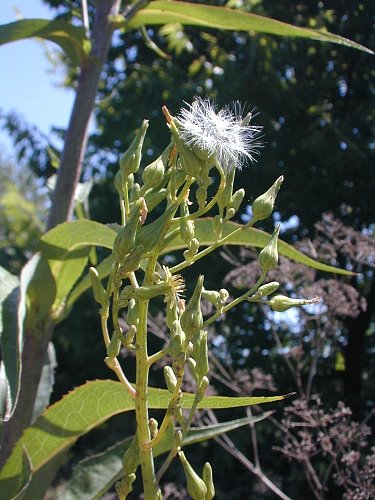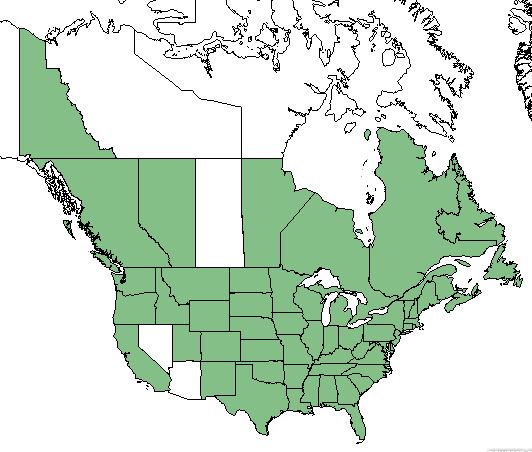Difference between revisions of "Lactuca canadensis"
Emmazeitler (talk | contribs) |
Emmazeitler (talk | contribs) |
||
| Line 25: | Line 25: | ||
==Description== <!-- Basic life history facts such as annual/perrenial, monoecious/dioecious, root morphology, seed type, etc. --> | ==Description== <!-- Basic life history facts such as annual/perrenial, monoecious/dioecious, root morphology, seed type, etc. --> | ||
| − | ''Lactuca canadensis'' is a dioecious annual and biennial that grows as a forb/herb.<ref name="USDA"/> Its inflorescence consist of a cluster of small pale yellow flowers. When crushed, its foliage excretes a milky juice. Leaves are alternate, simple, with lobed margins.<ref name="Ladybird">Plant database: ''Lactuca canadensis''. (30 January 2018) Lady Bird Johnson Wildflower Center. URL: https://www.wildflower.org/plants/result.php?id_plant=LACA</ref> Leaf shape changes with available water and sunlight. Growth in Denver swamps produced larger leaves while plants in direct sunlight were more lobed than the non-lobed plants grown in shade.<ref name="Talbert & Holch 1957">Talbert CM, Holch AE (1957) A study of the lobing of sun and shade leaves. Ecology 38(4):655-658.</ref> In Nebraska, it reaches 61 in (1.55 m) in height and 27 in (0.69 m) wide on the surface.<ref name="Ladybird"/> Roots are tender and milky spreading out 35 in (0.90 m) and reaching 26 in (0.66 m) deep.<ref name="Cole & Holch 1941">Cole HE, Holch AE (1941) The root habits of certain weeds of southeastern Nebraska. Ecology 22(2):141-147.</ref> | + | ''Lactuca canadensis'' is a dioecious annual and biennial that grows as a forb/herb.<ref name="USDA"/> Its inflorescence consist of a cluster of small pale yellow flowers. When crushed, its foliage excretes a milky juice. Leaves are alternate, simple, with lobed margins.<ref name="Ladybird">Plant database: ''Lactuca canadensis''. (30 January 2018) Lady Bird Johnson Wildflower Center. URL: https://www.wildflower.org/plants/result.php?id_plant=LACA</ref> Leaf shape changes with available water and sunlight. Growth in Denver swamps produced larger leaves while plants in direct sunlight were more lobed than the non-lobed plants grown in shade.<ref name="Talbert & Holch 1957">Talbert CM, Holch AE (1957) A study of the lobing of sun and shade leaves. Ecology 38(4):655-658.</ref> In Nebraska, it reaches 61 in (1.55 m) in height and 27 in (0.69 m) wide on the surface.<ref name="Ladybird"/> Roots are tender and milky, spreading out 35 in (0.90 m) and reaching 26 in (0.66 m) deep.<ref name="Cole & Holch 1941">Cole HE, Holch AE (1941) The root habits of certain weeds of southeastern Nebraska. Ecology 22(2):141-147.</ref> |
==Distribution== | ==Distribution== | ||
Revision as of 18:06, 17 September 2020
| Lactuca canadensis | |
|---|---|

| |
| Photo by the Illinois Wildflowers Database | |
| Scientific classification | |
| Kingdom: | Plantae |
| Division: | Magnoliophyta - Flowering plants |
| Class: | Magnoliopsida - Dicots |
| Order: | Asterales |
| Family: | Asteraceae |
| Genus: | Lactuca |
| Species: | L. canadensis |
| Binomial name | |
| Lactuca canadensis L. | |

| |
| Natural range of Lactuca canadensis from USDA NRCS Plants Database. | |
Common Name: American wild lettuce;[1] Canada lettuce[2]
Contents
Taxonomic Notes
Synonym: L. sagittifolia.[3]
Varieties: none.[3]
Description
Lactuca canadensis is a dioecious annual and biennial that grows as a forb/herb.[2] Its inflorescence consist of a cluster of small pale yellow flowers. When crushed, its foliage excretes a milky juice. Leaves are alternate, simple, with lobed margins.[4] Leaf shape changes with available water and sunlight. Growth in Denver swamps produced larger leaves while plants in direct sunlight were more lobed than the non-lobed plants grown in shade.[5] In Nebraska, it reaches 61 in (1.55 m) in height and 27 in (0.69 m) wide on the surface.[4] Roots are tender and milky, spreading out 35 in (0.90 m) and reaching 26 in (0.66 m) deep.[6]
Distribution
This species occurs in all of the lower 48 United States excluding Nevada and Arizona. In Canada, it is found in all the provinces except Saskatchewan, Nunavut, and Northwest Territories.[2]
Ecology
Habitat
L. canadensis is found in fields, roadsides, disturbed ground,[1] thickets, forest edges, and in forest clearings (as cited in [7])
L. canadensis responds both positively and negatively to soil disturbance by roller chopping and disturbance by a KG blade in East Texas Loblolly Pine-Hardwood Forests.[8]
Phenology
In the southeastern and mid-Atlantic United States, this species flowers from June through November.[1] Flowers on the Florida panhandle have been reported in May, June, and August, peaking in June.[9]
Seed dispersal
This species is thought to be dispersed by wind.[10]
Seed bank and germination
Tennessee topsoil produced 2,683 individuals ha-1 (26.83 individuals Dm-2).[11]
Use by animals
In Minnesota, browsing by white-tailed deer (Odocoileus virginianus) reduced the height (63.8 cm with browsing versus 136.9 cm without). Also, flowering was over 7 times greater on unbrowsed (231 flower heads per plant with browsing versus 1,725 without) L. canadensis plants.[12] Seeds from L. canadensis also provide a resource for wintering birds such as tree sparrows (Spizella arborea). In Illinois, seed traps found densities of 72 g seeds hm-2 during winter months.[13]
Conservation and Management
Cultivation and restoration
Photo Gallery
References and notes
- ↑ 1.0 1.1 1.2 Weakley AS (2015) Flora of the Southern and Mid-Atlantic States. Chapel Hill, NC: University of North Carolina Herbarium.
- ↑ 2.0 2.1 2.2 USDA NRCS (2016) The PLANTS Database (http://plants.usda.gov, 30 January 2018). National Plant Data Team, Greensboro, NC 27401-4901 USA.
- ↑ 3.0 3.1 Weakley, A.S. 2015. Flora of the southern and mid-atlantic states. Working Draft of 21 May 2015. University of North Carolina at Chapel Hill, Chapel Hill, North Carolina.
- ↑ 4.0 4.1 Plant database: Lactuca canadensis. (30 January 2018) Lady Bird Johnson Wildflower Center. URL: https://www.wildflower.org/plants/result.php?id_plant=LACA
- ↑ Talbert CM, Holch AE (1957) A study of the lobing of sun and shade leaves. Ecology 38(4):655-658.
- ↑ Cole HE, Holch AE (1941) The root habits of certain weeds of southeastern Nebraska. Ecology 22(2):141-147.
- ↑ Lebeda A, Dolezalova I, Ferakova V, Astley D (2004) Geographical distribution of wild Lactuca species (Asteraceae, Lactuceae). Botanical Review 70(3):328-356.
- ↑ Stransky, J.J., J.C. Huntley, and Wanda J. Risner. (1986). Net Community Production Dynamics in the Herb-Shrub Stratum of a Loblolly Pine-Hardwood Forest: Effects of CLearcutting and Site Preparation. Gen. Tech. Rep. SO-61. New Orleans, LA: U.S. Dept of Agriculture, Forest Service, Southern Forest Experiment Station. 11 p.
- ↑ Nelson, G. PanFlora: Plant data for the eastern United States with emphasis on the Southeastern Coastal Plains, Florida, and the Florida Panhandle. www.gilnelson.com/PanFlora/ Accessed: 30 JAN 2018/
- ↑ Kirkman, L. Katherine. Unpublished database of seed dispersal mode of plants found in Coastal Plain longleaf pine-grasslands of the Jones Ecological Research Center, Georgia.
- ↑ Farmer RE Jr, Cunningham M, Barnhill MA (1982) First-year development of plant communities originating from forest topsoils placed on southern Appalachian minesoils. Journal of Applied Ecology 19(1):283-294.
- ↑ Shelton AL, Inouye RS (1995) Effect of browsing by deer on the growth and reproductive success of Lactuca canadensis (Asteraceae). The American Midland Naturalist 134(2):332-339.
- ↑ West GC (1967) Nutrition of tree sparrows during winter in central Illinois. Ecology 48(1):58-67.